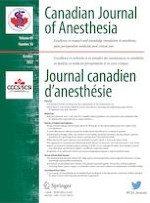Erschienen in:

09.08.2022 | Reports of Original Investigations
A novel ultrasound software system for lumbar level identification in obstetric patients
verfasst von:
Jorden Hetherington, MASc, Janette Brohan, MB, BCh, FCAI, Robert Rohling, PhD, Vit Gunka, MD, FRCPC, Purang Abolmaesumi, PhD, Arianne Albert, PhD, Anthony Chau, MD, FRCPC, MMSc
Erschienen in:
Canadian Journal of Anesthesia/Journal canadien d'anesthésie
|
Ausgabe 10/2022
Einloggen, um Zugang zu erhalten
Abstract
Purpose
Using machine learning, we developed a proprietary ultrasound software called the Spine Level Identification (SLIDE) system, which automatically identifies lumbar landmarks in real time as the operator slides the transducer over the lumber spine. Here, we assessed the agreement between SLIDE and manual palpation and traditional lumbar ultrasound (LUS) for determining the primary target L3–4 interspace.
Methods
Upon institutional ethics approval and informed consent, 76 healthy term parturients scheduled for elective Caesarean delivery were recruited. The L3–4 interspace was identified by manual palpation and then by the SLIDE method. The reference standard was located using traditional LUS by an experienced operator. The primary outcome was the L3–4 interspace identification agreement of manual palpation and SLIDE with the reference standard, as percentage agreement and Gwet’s agreement coefficient (AC1).
Results
The raw agreement was 70% with Gwet’s agreement coefficient (AC1) = 0.59 (95% confidence interval [CI], 0.41 to 0.77) for manual palpation and 84% with Gwet’s AC1 = 0.82 (95% CI, 0.70 to 0.93) for SLIDE. When the levels differ from the reference, the manual palpation method identified L2–3 more often than L4–5 while the SLIDE method identified equally above or below L3–4. The SLIDE system had greater agreement than palpation in locating L3–4 and all other lumber interspaces after controlling for body mass index (adjusted odds ratio, 2.99; 95% CI, 1.21 to 8.7; P = 0.02).
Conclusion
The SLIDE system had higher agreement with traditional ultrasound than manual palpation did in identifying L3–4 and all other lumber interspaces after adjusting for BMI in healthy term obstetric patients. Future studies should examine factors that affect agreement and ways to improve SLIDE for clinical integration.











